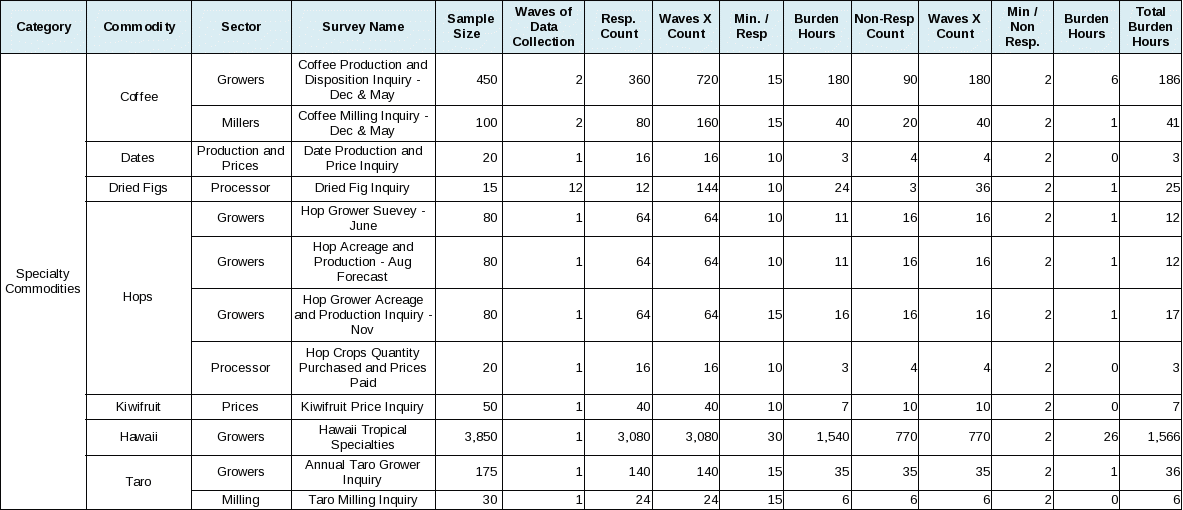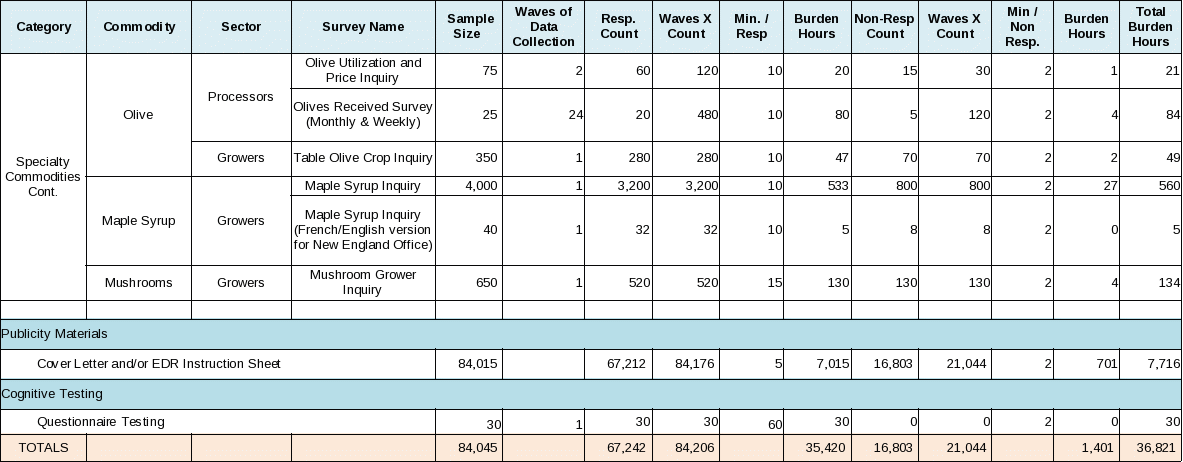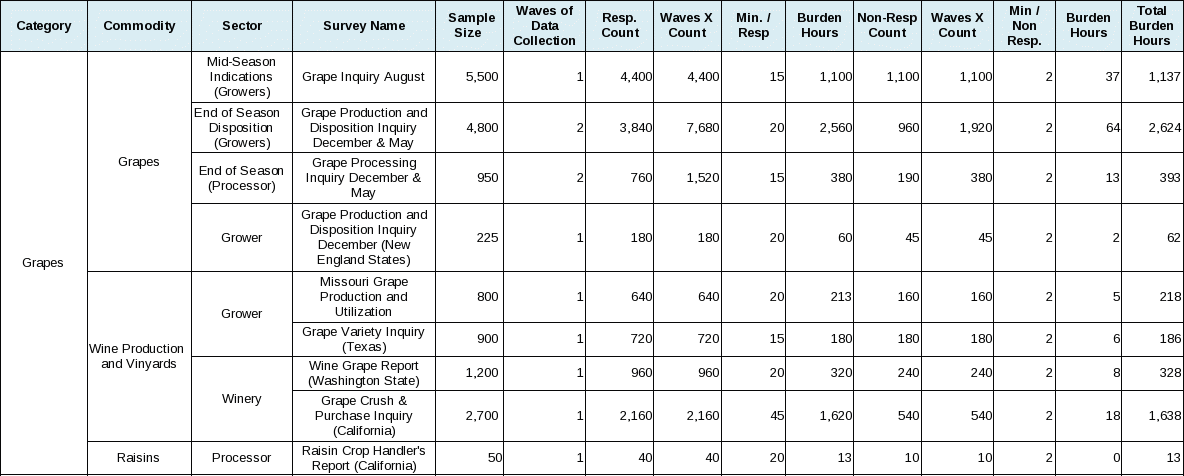0039-fruitnut-16-SSA - Sept 2016 - Rev
0039-fruitnut-16-SSA - Sept 2016 - Rev.docx
Fruit, Nuts, and Specialty Crops
OMB: 0535-0039
1 Supporting Statement - Part A
FRUIT, NUTS, AND SPECIALTY CROPS
OMB No. 0535-0039
TERMS OF CLEARANCE
NASS will submit an updated Nonresponse Bias Analysis Plan, reflecting the use of the OMB standard method of response rate calculation, the use of weighted response rates (reflecting coverage), and a non-response bias analysis plan, within 6 months of approval of this collection.
NASS REPLY
NASS has conducted a bias study of the non-citrus tree fruits and have attached the document to this submission as a supplemental document. It is titled Non-Citrus Tree Fruit Nonresponse Bias Analysis. Some of the smaller fruit, nut and specialty surveys that have not yet been standardized on a US level were not studied at this time.
A. JUSTIFICATION
1This submission is a request for approval of this long-running information collection for 3 years. There are several changes in the survey program resulting in an increase in responses and burden hours. Several new surveys have been added to the program that are being funded through cooperative agreements with State Departments of Agriculture.
1. Explain the circumstances that make the collection of information necessary. Identify any legal or administrative requirements that necessitate the collection. Attach a copy of the appropriate section of each statute and regulation mandating or authorizing the collection of information.
The primary function of the National Agricultural Statistics Service (NASS) is to prepare and issue current official State and national estimates of crop and livestock production, value, and disposition. Estimates of fruit, tree nuts, and specialty crops are an integral part of this program. These estimates support the NASS strategic plan to cover all agricultural cash receipts.
General authority for these data collection activities is granted under U.S. Code Title 7, Section 2204. This statute specifies that "The Secretary of Agriculture shall procure and preserve all information concerning agriculture which he can obtain ... by the collection of statistics ... and shall distribute them among agriculturists."
2. Indicate how, by whom, and for what purpose the information is to be used. Except for a new collection, indicate the actual use the agency has made of the information received from the current collection.
Data reported on fruit, nut, and specialty crops are used by NASS to estimate crop acreage, yield, production, utilization, price, and value in States with significant commercial production. These estimates are essential to farmers, processors, importers and exporters, shipping companies, cold storage facilities and handlers in making production and marketing decisions. Estimates from these inquiries are used by market order administrators in their determination of expected crop supplies under federal and State market orders.
Other government agencies also need these data. These data were used during the open trade negotiations with Canada and Mexico which resulted in the 1994 North American Free Trade Agreement. Since then the data has been used to measure the need for any adjustments to this agreement. Estimates for these commodities are also used by the Risk Management Agency (RMA) for crop insurance issues and by the Farm Services Agency (FSA) to determine disaster payments. The International Trade Commission has used these data to resolve anti-dumping investigations. Additionally, the information is used as base data for the Water Quality/Food Safety surveys.
Many of the larger bee and honey producers are dependent upon this data as they travel around the country leasing out their colonies to pollinate crops as they come into bloom.
3. Describe whether, and to what extent, the collection of information involves the use of automated, electronic, mechanical, or other technological collection techniques or other forms of information technology, e.g., permitting electronic submission of responses, and the basis for the decision for adopting this means of collection. Also describe any consideration of using information technology to reduce burden.
Nearly all of the larger NASS information collections have been converted to Web-based data collection, what NASS calls electronic data reporting or EDR. Conversion of the dozens of versions of the fruit, nut, and specialty crop questionnaires is progressing, where practical.
With the standardization of these questionnaires, NASS is planning to conduct more centralized surveys which will use fewer questionnaire versions and concentrate all data collections into fewer times during the year. This will help to reduce the number and frequency of contacts per respondent.
The main portal for our on-line surveys is http://www.agcounts.usda.gov.
Once there, the respondents have to enter the valid survey code and their own user ID, which is printed on the label of the questionnaire that was mailed to them. This limits access to the system to only those farm operators who were selected to be in the survey.
4. Describe efforts to identify duplication. Show specifically why any similar information already available cannot be used or modified for use for the purposes described in Item 2 above.
NASS cooperates with State departments of agriculture and land grant universities to conduct agricultural surveys. This eliminates duplication of data gathering by more than one agency. For the commodities in this docket, if information is available from State agencies and other federal agencies, then NASS will use these administrative data to reduce burden on the public.
The NASS, National Operations Division, Frames Maintenance Group, located in St. Louis, Missouri is responsible for maintaining and updating our List Frame of all known farming operations. By monitoring data collection periods for each commodity, cross-referencing growers by commodity, and combining information for multiple commodities on a single questionnaire, duplication of data collection is eliminated. Also, when the 2012 Census of Agriculture (0535-0226) was completed, the data were saved to our List Frame. Each year in the spring, NASS is able to adjust our stratified samples to better reflect changes in this industry. This keeps total respondent burden to the lowest possible level.
5. If the collection of information impacts small businesses or other small entities (Item 5 of OMB Form 83-I), describe any methods used to minimize burden.
Information from growers can be provided with a minimum of difficulty and generally without having to consult their record books. Information from processors can be completed from normal day-to-day operating records. Administrative data is obtained for commodities that are State or federally regulated, thereby eliminating burden on growers and processors. Administrative data from other entities are used whenever possible. In instances where administrative data provides sufficient coverage and accuracy, we consider these opportunities to discontinue surveys and reduce burden.
To further reduce overall respondent burden, NASS utilizes stratified simple random sampling and multivariate probability proportionate to size sampling designs, where possible; rather than conducting a complete enumeration of any group of specialty commodity producers. These designs significantly reduce the burden on the smaller producers as they are designed to select relatively larger producers.
6. Describe the consequence to Federal program or policy activities if the collection is not conducted or is conducted less frequently, as well as any technical or legal obstacles to reducing burden.
NASS has made adjustments, where possible, to reduce the frequency of data collections. Collecting data less frequently would prevent USDA and the agriculture industry from being kept abreast of changes at the State and national level. The diversity of commodities included in this docket and the varying seasonality of each commodity warrants the frequency of data collection currently used by NASS. Data are collected for the different stages of production and consumption of the different commodities, for production, sales, prices, processing, and stocks.
7. Explain any special circumstances that would cause an information collection to be conducted in a manner requiring respondents to report information to the agency more often than quarterly; requiring respondents to prepare a written response to a collection of information in fewer than 30 days after receipt of it;...
Historically, some surveys were conducted monthly during the growing season to keep USDA and the agriculture industry abreast of changes at the State and national level. Timing and frequency of the reports have evolved to meet the needs of producers, agribusinesses, and government agencies.
As part of an agreement with the California Department of Food and Agriculture, the Olives Received Surveys will be conducted weekly during the months of September, October, and November and monthly during the other months. Olives are an alternative bearing crop meaning one year there will be a large harvest and the next will have significantly less production. Collecting information less frequently will result in less precise knowledge of supply levels in the olive industry, and eliminates data needed to keep federal and state agencies, agribusiness suppliers, and other data users abreast of olive industry changes.
Many of the specialty crop, fruit, and nut surveys were conducted at times of the year that coincided with the crop growth cycle(s) and harvest or marketing periods. This has helped to increase the accuracy of the data by reducing any possible memory bias.
8. Provide a copy and identify the date and page number of publication in the Federal Register of the agency's notice, required by 5 CFR 1320.8 (d), soliciting comments on the information collection prior to submission to OMB. Summarize public comments received in response to that notice and describe actions taken by the agency in response to these comments.
The Federal Register Notice soliciting comments was published on March 29, 2016, on pages 17433 - 17434. NASS received 1 public comment from Ms. Jean Public.
Describe efforts to consult with persons outside the agency to obtain their views on the availability of data, frequency of collection, the clarity of instructions and recordkeeping, disclosure, or reporting format (if any), and on the data elements to be recorded, disclosed, or reported.
Consultations with the Extension Service, grower organizations, farmers, and other organizations occur on a regular basis, especially by our State and Regional Field Offices. NASS commodity statisticians will attend some of the various commodity meetings when possible.
9. Explain any decision to provide any payment or gift to respondents.
There are no payments or gifts to respondents.
10. Describe any assurance of confidentiality provided to respondents and the basis for the assurance in statute, regulation, or agency policy.
All questionnaires include a statement that individual reports are kept confidential. U.S. Code Title 18, Section 1905 and U.S. Code Title 7, Section 2276 provide for the confidentiality of reported information. All employees of NASS and all enumerators hired and supervised under a cooperative agreement with the National Association of State Departments of Agriculture (NASDA) must read the regulations and sign a statement of compliance. (Privacy Impact Statement is attached.)
Additionally, NASS and NASS contractors comply with OMB Implementation Guidance, “Implementation Guidance for Title V of the E-Government Act, Confidential Information Protection and Statistical Efficiency Act of 2002 (CIPSEA), (Public Law 107-347). CIPSEA supports NASS’ pledge of confidentiality to all respondents and facilitates the agency’s efforts to reduce burden by supporting statistical activities of collaborative agencies through designation of NASS agents; subject to the limitations and penalties described in CIPSEA.
The following CIPSEA Pledge statement will appear on all future NASS questionnaires.
The information you provide will be used for statistical purposes only. In accordance with the Confidential Information Protection provisions of Title V, Subtitle A, Public Law 107–347 and other applicable Federal laws, your responses will be kept confidential and will not be disclosed in identifiable form to anyone other than employees or agents. By law, every employee and agent has taken an oath and is subject to a jail term, a fine, or both if he or she willfully discloses ANY identifiable information about you or your operation.
Minor changes were made to the wording of the pledge so that it would be consistent with NASS procedures.
11. Provide additional justification for any questions of a sensitive nature.
There are no questions of a sensitive nature.
12. Provide estimates of the hour burden of the collection of information. The statement should indicate the number of respondents, frequency of response, annual hour burden, and an explanation of how the burden was estimated. If this request for approval covers more than one form, provide separate hour burden estimates for each form and aggregate the hour burdens in Item 13 of OMB Form 83-I. Provide estimates of annualized cost to respondents for the hour burdens for collections of information, identifying and using appropriate wage rate categories.
The renewal has a sample size of 84,045, a total number of 105,250 responses and a total of 36,816 burden hours.
Average minutes per response for the fruit, nut and specialty surveys are based on the amount of data asked on each questionnaire and the time needed for telephone follow-ups. Total hours of burden is shown in the tables below.
Cost to the public of completing a questionnaire is assumed to be comparable to the hourly rate of those requesting the data. Reporting time of 36,821 hours is multiplied by $25 per hour for a total cost to the public of $920,525.
NASS regularly checks the Bureau of Labor Statistics’ Occupational Employment Statistics (Published March 30, 2016). Mean wage rates for bookkeepers, farm managers, and farm supervisors are averaged to obtain the wage for the burden cost. The May 2015 mean wage for bookkeepers is $18.74. The mean wage for farm managers is $33.60. The mean wage for farm supervisors is $23.22. The mean wage of the three is $25.19.




The sample size is multiplied by 80% to get the Response Count. This is the target number of completed reports for each survey. The frequency of the surveys can vary with each survey, some are conducted monthly, some quarterly, some monthly-seasonal, some annually, etc. The non-response count consists of the 20% that are expected to be refusals or inaccessible records. The minutes per response are the average amount of time it takes to complete each questionnaire. Non-respondents are allotted 2 minutes to glance over the pre-survey letter or the questionnaire they receive in the mail before deciding to refuse to complete the survey.
The surveys that are being sent to processors or handlers are generally a complete census of this population, since these are relatively small populations. On the grower surveys we treated the largest producers as must records and included them all in our samples. For the medium and small size operations we selected a random sampling within each stratum for the target States. The estimate of burden for each of the surveys is based on a minimum target response rate of 80%.
13. Provide estimates of the total annual cost burden to respondents or record keepers resulting from the collection of information, (do not include the cost of any hour burden shown in items 12 and 14). The cost estimates should be split into two components: (a) a total capital and start-up cost component annualized over its expected useful life; and (b) a total operation and maintenance and purchase of services component.
There are no capital/start-up or ongoing operation/maintenance costs associated with this information collection.
14. Provide estimates of annualized cost to the Federal government; provide a description of the method used to estimate cost which should include quantification of hours, operational expenses (equipment, overhead, printing, and staff), and any other expense that would not have been incurred without this collection of information.
The total cost to the federal government to conduct the fruits, nuts and specialty crops surveys and prepare estimates is approximately $4.5 million. The majority of the total savings are for personnel costs associated with data collection, analytical review, summarization, and publication of reports. Previously NASS had one statistician in each Field Office who was responsible for reviewing and setting estimates for each of the fruits, nuts and specialty crops for that State.
With the standardization of questionnaires, and NASS’s move towards a Regional Field Office structure we have been able to consolidate the data collection, review, and estimation tasks. This consolidation of tasks will save NASS an estimated $500,000. While there was an overall increase in sample size and respondent burden, NASS was able to reduce overall costs, through the use of improved tools used for data collection, summarization and analysis of data. Previously each State would send out a commodity specific questionnaire to growers of that particular commodity who was selected to participate in our survey(s). With the continuation of the standardization of questionnaires we have eliminated more of the commodity specific questionnaires in favor of combined questionnaires. For example if a producer has several crops such as apples, peaches and pears, they will receive just the one questionnaire but all three commodities will be in the same form, rather than sending out 3 separate questionnaires. Within the internet versions and the Computer Assisted Telephone Interviews (CATI) the increased use of screening questions helps to streamline the questionnaires and ask only the questions that are relevant to each respondent or each region of the country. The longer, more comprehensive surveys will only be conducted once in mid-season and once at the end of the season.
Since the previous submission NASS continues to work at consolidating and standardizing more of the questionnaires we are using.
NASS has several agreements with State Departments of Agriculture to conduct several of these surveys. These surveys are collected under the same methodology used on the other NASS surveys and are protected under the same confidentiality we have for all of our surveys. The costs for these surveys is incurred by the individual States and are calculated based on the costs of similar surveys conducted by NASS for the Federal Government.
15. Explain the reasons for any program changes or adjustments reported in Items 13 or 14 of the OMB Form 83-I (reasons for changes in burden).
The new annual burden of 36,821 hours is up 18,463 hours above the previous inventory of 18,358 hours. The increase is a result of several miscellaneous program changes. NASS has entered into an agreement with the California Department of Food and Agriculture to conduct additional surveys for almonds, citrus, grapes, olives, prunes, and walnut producers to satisfy industry needs not covered by Federal Appropriations.
Additional burden is requested for Connecticut, Maine, Massachusetts, Missouri, New Hampshire, Rhode Island, Texas, Vermont, and Washington to conduct grape production and variety surveys for ongoing agreements to measure supplies for wine and other processed grapes.
NASS continues to combine many of our smaller surveys into fewer combined questionnaires. This will allow us to collect data on multiple commodities at the same time.
16. For collections of information whose results will be published, outline plans for tabulation and publication. Address any complex analytical techniques that will be used. Provide the time schedule for the entire project, including beginning and ending dates of the collection of information, completion of report, publication dates, and other actions.
Questionnaires for all surveys in this information collection are returned to the State or Regional Field Offices and reviewed for reasonableness prior to keying into data processing media for summarization. State and/or Regional statisticians analyze survey results, recommend estimates or forecasts for their State(s), and transmit the data to Washington, D.C. State survey results are summarized nationally and by major regions or State groupings. Individual State recommendations are reviewed and changed, if necessary, to reach national and regional estimates.
During the forecast season, questionnaires are mailed to growers with a reference date of the first of the month. Most production forecasts are released in the Agency's monthly Crop Production report released between the 8th and 13th of the same month. Exceptions are the mid-June forecasts of sweet and tart cherries and the mid-August forecast of cranberries which are issued separately.
Growers’ disposition questionnaires are mailed soon after completion of harvest for non-storage crops or at the end of the marketing season for storage fruits. End-of-season estimates for all noncitrus crops are published in the January Noncitrus Fruits and Nuts Preliminary Summary. The Noncitrus Fruits and Nuts Summary report is issued the following July to show final utilization and value estimates for storage crops such as apples, grapes, pears, and tree nuts. Also included are miscellaneous crops in California and Hawaii for which final market records and processor data were not available in December. End-of-season citrus acreage, yield, production, price, and value estimates including final utilization and price data for the previous marketing season are published in the September Citrus Fruits release.
Orchard and Vineyard Inventory Surveys are issued as special reports. Generally, inventory surveys are conducted January through March. Bearing acreage and yields per bearing acre are published by State and crop in the Citrus Fruits Summary and the Noncitrus Fruits and Nuts Preliminary Summary and final Summary.
These publications are available on-line immediately after release at:
http://www.nass.usda.gov/Statistics_by_Subject/index.php?sector=CROPS
Once there, select the commodity group and then the item of interest.
A complete listing of the NASS data publications can be found at the following web site:
https://www.nass.usda.gov/Publications/Reports_by_Release_Day/
17. If seeking approval to not display the expiration date for OMB approval of the information collection, explain the reasons that display would be inappropriate.
There is no request for approval of non-display of the expiration date.
18. Explain each exception to the certification statement identified in Item 19, “Certification for Paperwork Reduction Act Submissions” of OMB Form 83-I.
There are no exceptions to the certification statement.
July 2016
Revised Sept 2016
| File Type | application/vnd.openxmlformats-officedocument.wordprocessingml.document |
| Author | David Hancock |
| File Modified | 0000-00-00 |
| File Created | 2021-01-22 |
© 2025 OMB.report | Privacy Policy
